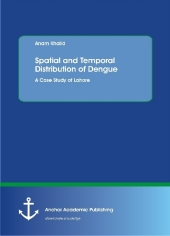 Neuerscheinungen 2016Stand: 2020-02-01 |
Schnellsuche
ISBN/Stichwort/Autor
|
Herderstraße 10
10625 Berlin
Tel.: 030 315 714 16
Fax 030 315 714 14
info@buchspektrum.de |

Anam Khalid
Spatial and Temporal Distribution of Dengue. A Case Study of Lahore
2016. 64 S. 23 Abb. 220 mm
Verlag/Jahr: ANCHOR ACADEMIC PUBLISHING 2016
ISBN: 3-9606705-3-2 (3960670532)
Neue ISBN: 978-3-9606705-3-7 (9783960670537)
Preis und Lieferzeit: Bitte klicken
This study was conducted to evaluate the dengue outbreaks pattern in spatial and temporal contexts and to identify the meteorological constraints behind the spread. The aim was to gain a complete picture of the scenario. The Lahore District was selected as the study area which was affected by mosquitoes to a great extent. Lahore is the second largest city of Pakistan with respect to its population due to its rapidly growing urbanization. The environmental factors affecting the spread of the disease have been identified and then mapped in a GIS based environment by using all the spatial and tabular data obtained from different sources. The factors affecting dengue spread were found to be Land Surface Temperature (LST), Land cover/Land use, Normalized Difference Vegetation Index (NDVI), Temperature, Rainfall, and Population Density.
Text Sample:
Chapter 3.1 Profile of Study Area:
A descriptive study was conducted in one of the Eastern District of the Punjab province i.e. Lahore. The reason behind the selection of this district is the highest occurrence of dengue fever all over the Pakistan. Lahore is the second largest city of Pakistan with an area of 1772 km2 and among the most densely populated cities of the world with a population of over 8 million. It is a rapidly growing and developing city and has become Centre of attraction for the people willing to migrate from rural areas for better livelihood. This has caused a rapid increase in the population of the city during past years. [...].
The Land cover/ Land use of the study area (built up, agricultural, swimming pools, stagnant water ponds, more area covered by parks etc.) in combination with the lack of strategic designs for mosquito sprays is observed to be quite suitable for the breeding of the mosquitoes.
According to the data collected by WHO (World Health Organization), more than 7000 people were victimized by dengue during the year 2011 only. The situation can become even worse if suitable actions would not been taken by the concerned authorities.
3.2 Geographic Location of Study Area:
It is located in the geographic extents of 31o 15´and 31o 45´ latitude and 74o 01´ and 74o 39´ longitude. The whole district is divided into nine towns which are further distributed in 150 Union Councils. A descriptive map of the towns and Union Councils of the study area is illustrated in the figure: [...].
3.3 Land Cover of Study Area:
Lahore is a metropolitan with a rapidly increasing population. The built up area of the city is increasing with each passing day. The imagery of Landsat V was classified using supervised classification technique with nearest neighbor interpolation and eventually got nine major Land Cover classed named; river, Canal, Vegetation, Low dense built up, high dense built up and medium dense built up, Soil, clouds and a mixed class where soil and low built up areas got mixed. The percentage of each type of land cover is shown in the table below: [...].
3.4 Hydrological Layer of Lahore City:
Lahore is the city of a river names river Ravi passing through the eastern part of the city and a major canal passing through almost the Centre of the city. Moreover, there are a number of small ponds and other water bodies are also found in the metropolitan. They include permanent and temporary water ponds. Temporary water ponds include the small water accumulation sites where water gets accumulated for a number of reasons. They include rainfall and poor sewerage system etc. a detailed hydrological map of Lahore city is figured below: [...].


